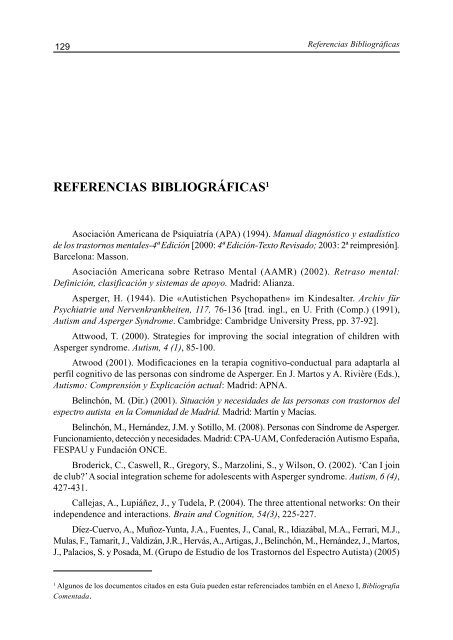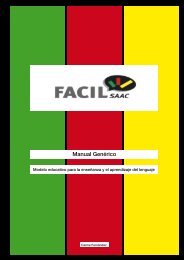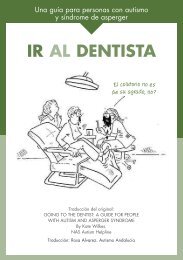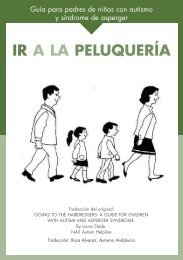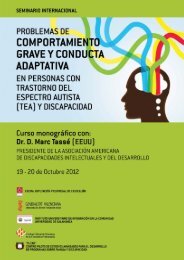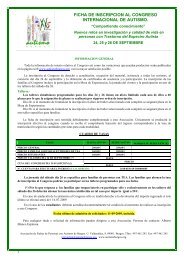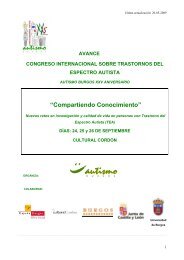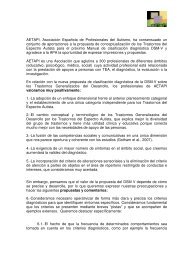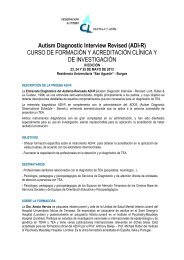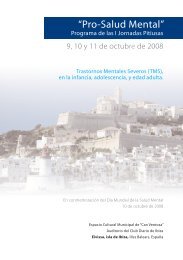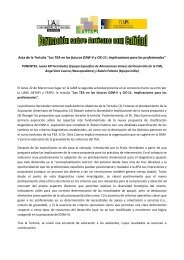Síndrome de Asperger: Una guía para los profesionales - Aetapi
Síndrome de Asperger: Una guía para los profesionales - Aetapi
Síndrome de Asperger: Una guía para los profesionales - Aetapi
Create successful ePaper yourself
Turn your PDF publications into a flip-book with our unique Google optimized e-Paper software.
129<br />
REFERENCIAS BIBLIOGRÁFICAS 1<br />
Asociación Americana <strong>de</strong> Psiquiatría (APA) (1994). Manual diagnóstico y estadístico<br />
<strong>de</strong> <strong>los</strong> trastornos mentales-4ª Edición [2000: 4ª Edición-Texto Revisado; 2003: 2ª reimpresión].<br />
Barcelona: Masson.<br />
Asociación Americana sobre Retraso Mental (AAMR) (2002). Retraso mental:<br />
Definición, clasificación y sistemas <strong>de</strong> apoyo. Madrid: Alianza.<br />
<strong>Asperger</strong>, H. (1944). Die «Autistichen Psychopathen» im Kin<strong>de</strong>salter. Archiv für<br />
Psychiatrie und Nervenkrankheiten, 117, 76-136 [trad. ingl., en U. Frith (Comp.) (1991),<br />
Autism and <strong>Asperger</strong> Syndrome. Cambridge: Cambridge University Press, pp. 37-92].<br />
Attwood, T. (2000). Strategies for improving the social integration of children with<br />
<strong>Asperger</strong> syndrome. Autism, 4 (1), 85-100.<br />
Atwood (2001). Modificaciones en la terapia cognitivo-conductual <strong>para</strong> adaptarla al<br />
perfil cognitivo <strong>de</strong> las personas con síndrome <strong>de</strong> <strong>Asperger</strong>. En J. Martos y A. Rivière (Eds.),<br />
Autismo: Comprensión y Explicación actual: Madrid: APNA.<br />
Belinchón, M. (Dir.) (2001). Situación y necesida<strong>de</strong>s <strong>de</strong> las personas con trastornos <strong>de</strong>l<br />
espectro autista en la Comunidad <strong>de</strong> Madrid. Madrid: Martín y Macías.<br />
Belinchón, M., Hernán<strong>de</strong>z, J.M. y Sotillo, M. (2008). Personas con <strong>Síndrome</strong> <strong>de</strong> <strong>Asperger</strong>.<br />
Funcionamiento, <strong>de</strong>tección y necesida<strong>de</strong>s. Madrid: CPA-UAM, Confe<strong>de</strong>ración Autismo España,<br />
FESPAU y Fundación ONCE.<br />
Bro<strong>de</strong>rick, C., Caswell, R., Gregory, S., Marzolini, S., y Wilson, O. (2002). ‘Can I join<br />
<strong>de</strong> club?’ A social integration scheme for adolescents with <strong>Asperger</strong> syndrome. Autism, 6 (4),<br />
427-431.<br />
Callejas, A., Lupiáñez, J., y Tu<strong>de</strong>la, P. (2004). The three attentional networks: On their<br />
in<strong>de</strong>pen<strong>de</strong>nce and interactions. Brain and Cognition, 54(3), 225-227.<br />
Díez-Cuervo, A., Muñoz-Yunta, J.A., Fuentes, J., Canal, R., Idiazábal, M.A., Ferrari, M.J.,<br />
Mulas, F., Tamarit, J., Valdizán, J.R., Hervás, A., Artigas, J., Belinchón, M., Hernán<strong>de</strong>z, J., Martos,<br />
J., Palacios, S. y Posada, M. (Grupo <strong>de</strong> Estudio <strong>de</strong> <strong>los</strong> Trastornos <strong>de</strong>l Espectro Autista) (2005)<br />
1 Algunos <strong>de</strong> <strong>los</strong> documentos citados en esta Guía pue<strong>de</strong>n estar referenciados también en el Anexo I, Bibliografia<br />
Comentada.<br />
Referencias Bibliográficas


